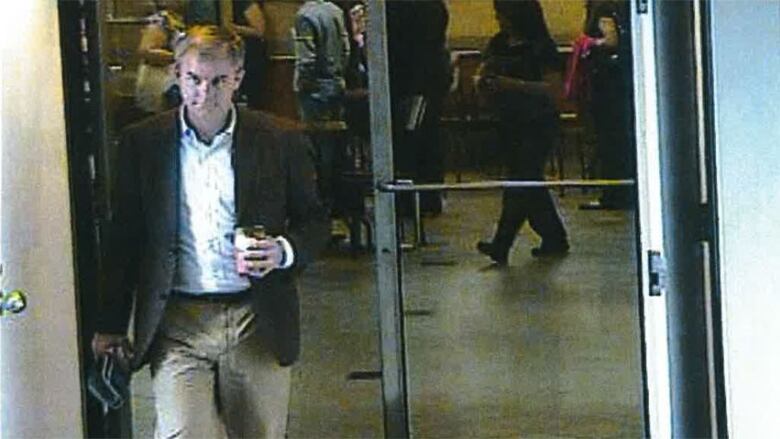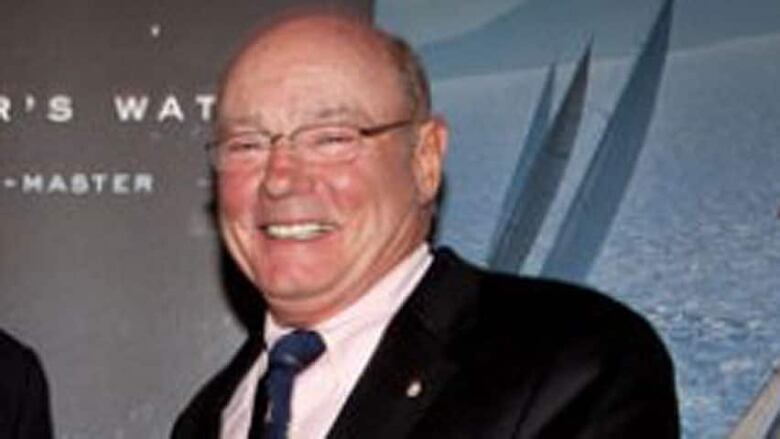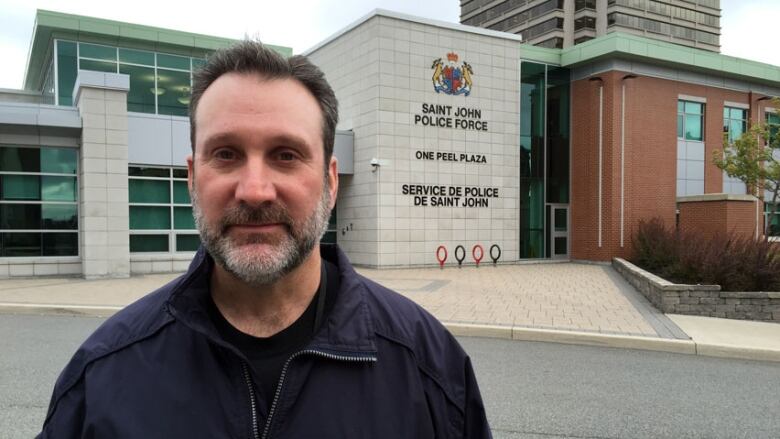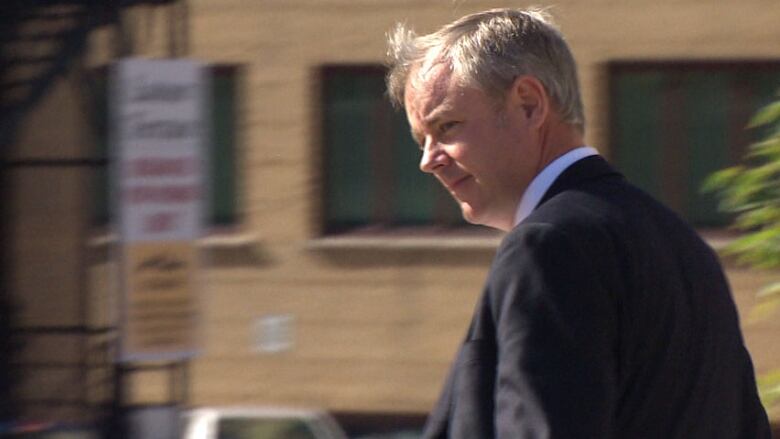Dennis Oland murder trial sees brown jacket, blood, DNA submitted
Juror No. 7 discharged after an association with someone involved in case comes to light

The Saint John Police Force gathered more than 564 pieces of evidence in the 2011 death of Richard Oland, the head of the forensic identification unit testified Mondayat Dennis Oland's second-degree murder trial.
Sgt. Mark Smith submitted several of those items as exhibits, includingakey piece of evidence in the Crown's case against Dennis Oland a brown sports jacket seized from his bedroom closet a week after his father's bludgeoned body was discovered in his uptown office.
P.J.Veniot, the lead Crown prosecutor,previouslytold the court during his opening statement to the jury that the jacket, which had been drycleaned, had four areas of blood on it and the DNA profile matched that of RichardOland.
Police believe DennisOland, 47,was wearing the jacket the day his father was killed, based on video surveillance of him earlier in the day, as well as a statement from the victim's secretary,Maureen Adamson.
The accused, who is the last known person to see his father alive during a visit at his office on July 6, 2011, around 5:30 p.m.,told police he was wearing a navy blazer at the time.

Smith testified last Friday that theRCMPlabs in Halifax and Fredericton hadlimited the number of exhibits the Saint John police could submit and that investigators had to wait for all of results to come back before sending any more.
The jacket was part of the eleventh submission to theRCMP, Smith told the court on Monday. It, like other exhibits,was carefully catalogued and secured to prevent any mixups or tampering, the court heard as Smith explained the complex process for the jury.
Someof the exhibits have been kept in a police freezer or refrigerator to preserve them, said Smith, who wore blue latex gloves to handle the ones labelled as biohazards.

RichardOland'sbody was discovered lying face down in a pool of blood in his investment firmoffice on July 7, 2011, with hundreds of blood spatter stains around him, some as far as nine feet away.
The prominent businessman had suffered 40 sharp and blunt force injuries to his head and neck,as well as six defensive wounds to his hands.
"The injuries were completely through his skull in some places," Smith has said.
The defence contends the killer would have had blood on him or her because the slaying was "up front and close with a lot of blood flying through the air."
Bathroom sink tested positive for blood
Smith told the court Monday thata swab of the sink of the bathroom located in the foyer outside Richard Oland'ssecond-floorofficeat 52 Canterbury St., had tested positive for blood during a preliminary test.
The swab, which turned "greenish-blue" when a chemical calledleucomalachite(LMG)was applied, was sent away to the RCMP for further analysis andsubmitted as an exhibit.

Smith did not discuss any of the findings on Monday, which was his third day of testimony. The Crown will call DNA experts to testify later in the trial, the courtroom heard.
DNA samples from other people, some of which were obtained surreptitiously, were also marked as exhibits in the trial.
Among them were"castoff" samples for Derek Oland, who is Richard Oland's brother and the executive chairman of MooseheadBreweries. The samples were obtained from a fork and drinking glass from the Bourbon Quarter restaurant in Saint John, said Smith.
Similarly, police seized a straw used by Bob McFadden, who also worked at Oland's office,was co-executor of his will and ended up taking over as president of the Far End Corporation. The straw was obtained from East Side Mario's, Smith said.
A consent DNA sample was also obtained from McFadden's son, Galen, he said.
Smith did not explain on Monday why the other DNA samples were obtained.
iPhone cable was tested
The USB cord for Richard Oland's iPhoneis another exhibit in the case.
Smith said he tested it for fingerprints, but couldn't get enough detail. He subsequently swabbed the cordfor DNA, he said.
Tech crime analysts previously testified that the iPhone was connected to Richard Oland's main office computer until 4:44 p.m., on July 6, 2011.
The iPhone was the only item that disappeared from the office and was never located.
A red Sobeys Complimentsreusable grocery bag, which wasseized from the trunk of Dennis Oland's Volkswagon Golf andtested for latent traces of blood, was also submitted.
RichardOland's secretary's husband, William Adamson, previously testified to seeing a man wearing a brown jacket enter the office on July 6, 2011, carryinga bag matching that description.
Juror discharged
The jury lost another memberon Monday.
Juror No.7 was discharged after an association he had with someone involved in the case came to the attention of the court.
The jury is now down to 13 members for the rest of the trial, which is scheduled to run until Dec. 18.
A minimum of 10 is required to deliver a verdict. Otherwise, a mistrial would bedeclared.
It would be up to the Crown to decide whether it wants to proceed with a new trial.
Court of Queen's Bench Justice John Walsh told the jury that juror No. 7 was dismissed due toan association that "unbeknownst to him" would have disqualified him as a juror.
If the jurorand the court had realized it during the jury selection, he never would have been chosen, Walsh said.
But it is "reasonable cause to discharge," he said.
Another juror was 'unable to serve'
This is the second juror the case has lost. On Sept.16, the judge said juror No. 4 was unable to serve and someone who had been selected as an alternate was named a juror.
Fourteen jurors and two alternates were selected instead of the normal 12-member panel because the trial is scheduled to last 65 days, increasing the chances someone will get sick or be unable to serve for some other reason.
The second alternate was dismissed at the start of the trial.
The judge previously told the jurors that all of themwill sit through all of the evidence and arguments, but only 12 of them will deliberate and give a verdict.
He said if more than 12 jurors remainon the panel once deliberations begin, any extras will be eliminated by a random draw.
There is a publication ban on anything that would identify the jurors.
A total of 5,000 people were summonsed for potential jury duty, making it one of the largest if not the largest jury panel in New Brunswick history.
It was significantly larger than some of the most high-profile cases across Canada that have generated international headlines, including Luka Magnotta, Robert Pickton and Paul Bernardo.
Normally,only about 300 people are summonsed for trials in New Brunswick.
The trial resumes on Tuesday morning with a fourth day of testimony from Sgt. Mark Smith.












_(720p).jpg)


 OFFICIAL HD MUSIC VIDEO.jpg)
.jpg)



























































































